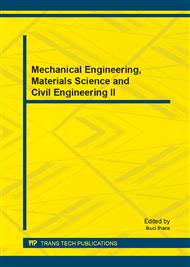p.48
p.53
p.58
p.62
p.66
p.70
p.76
p.80
p.84
Preparation of Monodisperse Functional Polystyrene/Silica Microsphere Composite via Suspension Polymerization Method
Abstract:
The monodisperse functional Polystyrene/Silica (PS/silica) microsphere has been successfully prepared via suspension polymerization followed by the modified silica composite phenylethylene method. The FTIR, SEM, EDS and BEI were used to characterize the structure and composition of monodisperse functional PS/Silica microspheres. The results indicated that the dosage of silica modifier affect the compatibility of the modified silica and phenyl ethylene. The several modified silica would synergistically impact on the morphology and performance of products corresponding to distinguish formation mechanisms. The thermal stability and compressive strength performance had been improved compared with polystyrene (PS).The weight loss of PS/Silica microspheres were less than polystyrene (PS) which weightlessness ratio is 96.92 wt %. The compressive strength of PS/Silica microspheres was almost two times as many as pure PS microspheres. The formation mechanism of monodisperse functional PS/Silica microsphere was developed ahead according to the results of FTIR, SEM, EDS and BEI under various polymerization conditions.
Info:
Periodical:
Pages:
66-69
Citation:
Online since:
December 2013
Authors:
Price:
Сopyright:
© 2014 Trans Tech Publications Ltd. All Rights Reserved
Share:
Citation:


